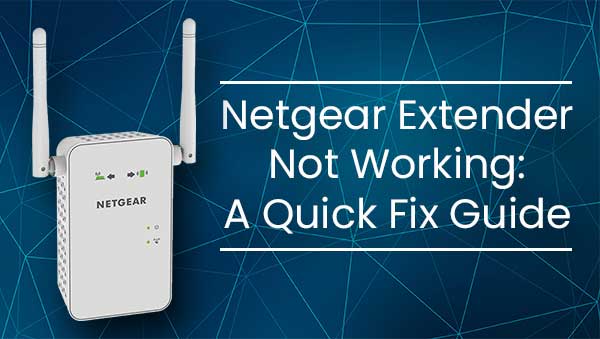There are many ways to solve weak Wi-Fi spots in our homes. We can try adding routers to other rooms in our house, or we can try setting up a Wi-Fi mesh network. Another solution might be setting up a Wi-Fi extender in one of our rooms to improve the signal.
However, like with any other piece of hardware we want to use to make our lives easier there can be issues. That’s why our Netgear extender is not working, and that’s why we need to understand how extenders work, how to set it up, and how to fix the issue.

CONTENTS
How Do Range Extenders Work?
A great thing about Wi-Fi extenders is they grab your wireless network and connect to it wirelessly. The extenders use both bands of your router, the 2.4 GHz (Gigahertz) band, and the 5 GHz band. This is the frequency of your wireless signal, and this is the frequency used by your wireless range extender.
Simply put, the extender grabs your router’s wireless signal and retransmits it to the area you want to be covered in your house. The thing is that it doesn’t use the same signal, it emits a different signal.
You won’t get a much stronger signal, you’ll simply get a wireless signal in a different part of your home that uses internet access from your router. This is how any range extender works, including the Netgear extenders.
Setting Up Your Netgear Extender
There’s a clear procedure for setting up a Wi-Fi extender. However, every manufacturer has its own steps. For Netgear Wi-Fi extenders there are a few steps we need to follow to set them up correctly:
- Once we’ve plugged in the extender where we want to have a better signal, we need to power it on using the Power button.
- There’s going to be an SSID (network name) called NETGEAR_EXT, there’s no password on that network.
- Now, we need to enter the settings page of the extender, it’s like a router’s settings page, and we use the default IP (Internet Protocol) address of the extender to access the page in the address bar of our browser. It should be 192.168.1.250, but you can also use www.mywifiext.net.
- Once we’re there, we’ll see the New Extender Setup, and we need to change the credentials we use to log into the extender.
- The extender will find your current wireless network and you need to connect to it.
- Once you connect to it, you’ll have the extender broadcasting the _2GEXT and _5GEXT networks.
- Finally, we need to click on NEXT, and the settings apply. Now, we have a functioning Netgear Wi-Fi extender in our home.
Netgear Extender Not Working Fixes
Knowing how to correctly set up a piece of hardware in your home is half the job. It can prevent some annoying issues and problems that occur like the Netgear extender not working. So, even if we know how to set it up correctly, we should also know how we can fix the issue when it happens.
Firmware update
One of the most common reasons our Netgear extender is not working is outdated firmware, so we need to update it to see if the problem gets solved. The extender needs to be plugged into an outlet.
The next step is the same as the third step in setting up the extender. We need to log into the settings page of the extender using the IP, or we can use www.mywifiext.net. If there’s a new firmware upgrade available, we’ll see a message saying that.
In that case, we only need to click on the message, and the firmware will be updated. Sometimes, we need to do this the harder way, and that’s when we have to go to the Maintenance section on the left pane.
When we click to expand the section, we’ll see Firmware Update. We need to click on that, and then there’s going to be a Check or Check Online button on the Device Update page. Finally, we need to reset the extender. After we’ve done that, our Netgear extender should work perfectly fine.
Recommended reading:
- Netgear Firmware Update Stuck
- Fixing the Belkin N300 WiFi Range Extender Orange Light
- Netgear Extender Red Light: How to Fix It?
Netgear extender reconnect
Sometimes, our Netgear extender is not working because it’s disconnected from our router. We get the signal, but there’s no internet access. This can be handled in two different ways, by connecting via an ethernet cable or wirelessly.
We can connect our extender and laptop using an Ethernet cable. Next, access the extender settings page and enter your credentials or the default username and password (admin and password).
Go to Setup and click on Wireless Settings. There’s going to be a section for Security options, that’s where you’ll need to verify the password of your router’s wireless network. Once we click on Apply, we can connect to the extender’s network.
The other way to do it is to do a factory reset. There’s a Reset button on the extender that we need to push for at least 30 seconds. Once we do a factory reset, all we need to do next is go through the setup process again. This should get your Netgear extender working properly.
Get a better solution
Sometimes, the thing is that Netgear’s extenders are just not compatible with the modem or router you have at home. So, it doesn’t matter if you have the best Wi-Fi range extender, the firmware of the extender and your modem or router is not compatible.
The best course of action here would be for you to get another extender brand or a different solution. In our opinion, a mesh Wi-Fi network setup can be much better than adding extenders throughout the home.
Conclusions
When something doesn’t work like it’s supposed to, it’s usually because we set it up wrong. That’s why we can notice our Netgear extender not working from time to time. But, now we know how to set it up correctly.
And, if the problem persists, we know how to fix it using the extenders settings page, and other options. This should do the trick, but if you’re still experiencing trouble with the extender, it might be time to switch to another model or brand.

Hey, I’m David. I’ve been working as a wireless network engineer and a network administrator for 15 years. During my studies, I also worked as an ISP field technician – that’s when I met Jeremy.
I hold a bachelor’s degree in network engineering and a master’s degree in computer science and engineering. I’m also a Cisco-certified service provider.
In my professional career, I worked for router/modem manufacturers and internet providers. I like to think that I’m good at explaining network-related issues in simple terms. That’s exactly what I’m doing on this website – I’m making simple and easy-to-follow guides on how to install, set up, and troubleshoot your networking hardware. I also review new network equipment – modems, gateways, switches, routers, extenders, mesh systems, cables, etc.
My goal is to help regular users with their everyday network issues, educate them, and make them less scared of their equipment. In my articles, you can find tips on what to look for when buying new networking hardware, and how to adjust your network settings to get the most out of your wi-fi.
Since my work is closely related to computers, servers, and other network equipment, I like to spend most of my spare time outdoors. When I want to blow off some steam, I like to ride my bike. I also love hiking and swimming. When I need to calm down and clear my mind, my go-to activity is fishing.
